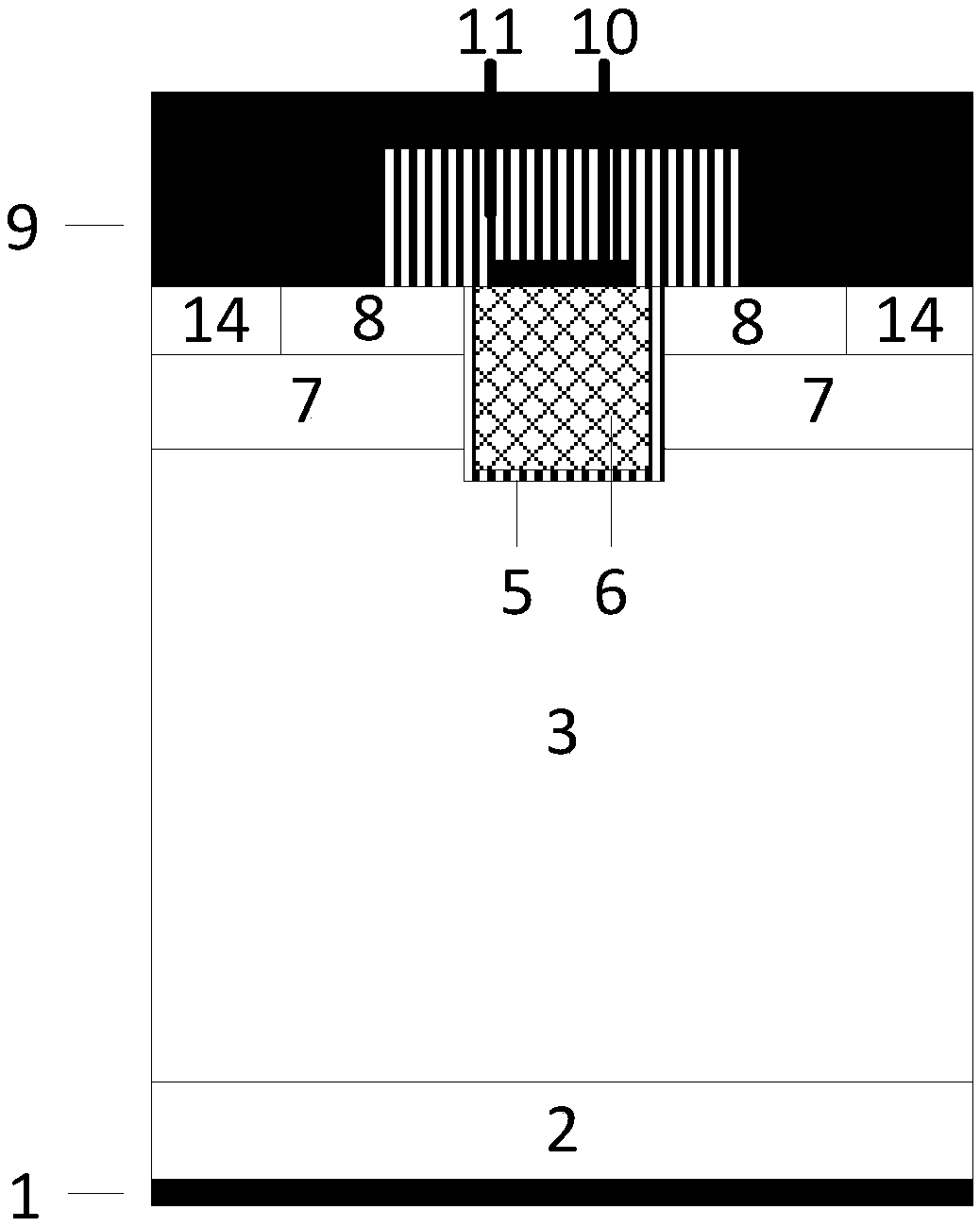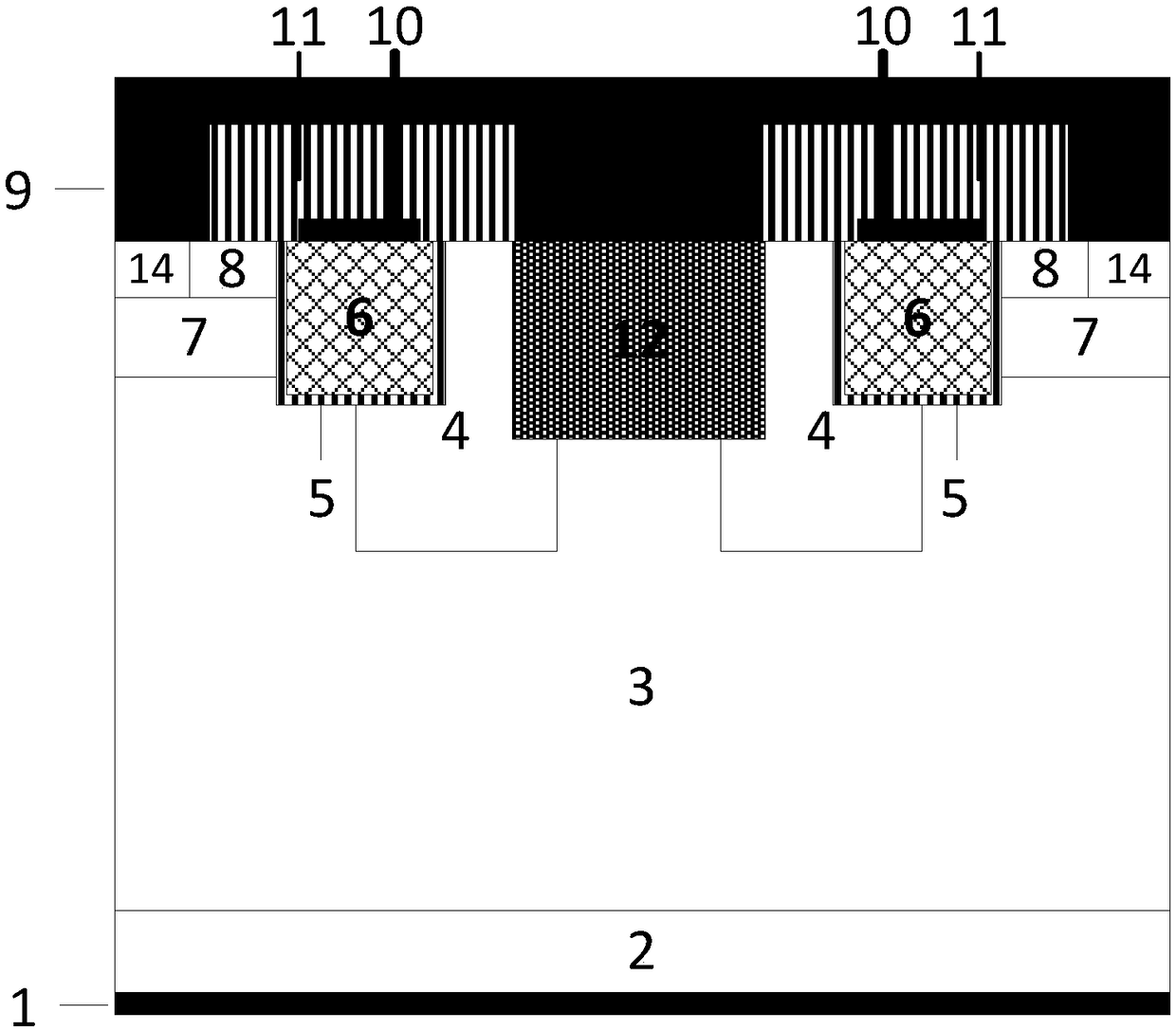Silicon carbide MOSFET device and manufacturing method thereof
A silicon carbide and device technology, applied in semiconductor devices, electrical components, circuits, etc., can solve problems such as low work efficiency, high power loss, and poor robustness
- Summary
- Abstract
- Description
- Claims
- Application Information
AI Technical Summary
Problems solved by technology
Method used
Image
Examples
Embodiment 1
[0074] A silicon carbide MOSFET device such as figure 2 As shown, the cell structure includes drain metal 1, silicon carbide N + Substrate 2 and SiC N - epitaxial layer 3; the silicon carbide N - There is a source trench above the epitaxial layer 3, and the source trench is filled by deposition of Schottky contact metal 12 or polysilicon 13, and the Schottky contact metal 12 or polysilicon 13 is in direct contact with the silicon carbide N- epitaxial layer 3, Form a Schottky contact or Si / SiC heterojunction contact with rectification characteristics; the left and right sides of the Schottky contact metal 12 on the semiconductor surface are respectively embedded with a silicon carbide deep P-doped region 4, and the two silicon carbide deep The depth of the P-doped region 4 is deeper than the bottom of the Schottky contact metal 12, the top left of the Schottky contact metal 12 is silicon carbide deep P-doped region 4, and the right side of the Schottky contact metal 12 is de...
Embodiment 2
[0076] Such as image 3 As shown, this embodiment is roughly the same as Embodiment 1, except that the structure does not have a silicon carbide P+ contact region 14, but on the upper left of the silicon carbide N- epitaxial layer 3, the silicon carbide Pbase region 7 and the carbide The left side of the silicon N+ source region 8 has a silicon carbide deep P-doped region 4 , and the silicon carbide deep P-doped region 4 has the same depth as the silicon carbide deep P-doped region 4 near the gate structure. This improvement helps to strengthen the protection of the silicon carbide deep P-doped region 4 on the semiconductor surface structure, so that the long-term application reliability of the device is improved.
Embodiment 3
[0078] The structure of this embodiment is substantially the same as that of Embodiment 1, except that the Schottky contact metal 12 region used is replaced by polysilicon 13, as Figure 4 shown. Also, a Si / SiC heterojunction structure with a rectifying contact is formed on the bottom sidewall of the source trench and the silicon carbide N- epitaxial layer 3 . The forward conduction voltage drop Von of the heterojunction structure is about 1.1V, which also has a good effect on improving the operation of the third quadrant of the device. At the same time, since the heterojunction is a multi-sub-device, the diode has good reverse recovery performance.
PUM
| Property | Measurement | Unit |
|---|---|---|
| Thickness | aaaaa | aaaaa |
| Width | aaaaa | aaaaa |
| Thickness | aaaaa | aaaaa |
Abstract
Description
Claims
Application Information
 Login to View More
Login to View More - R&D
- Intellectual Property
- Life Sciences
- Materials
- Tech Scout
- Unparalleled Data Quality
- Higher Quality Content
- 60% Fewer Hallucinations
Browse by: Latest US Patents, China's latest patents, Technical Efficacy Thesaurus, Application Domain, Technology Topic, Popular Technical Reports.
© 2025 PatSnap. All rights reserved.Legal|Privacy policy|Modern Slavery Act Transparency Statement|Sitemap|About US| Contact US: help@patsnap.com



